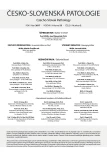Injuries associated with cardiopulmonary resuscitation in non-survivors after out-of-hospital cardiac arrest (autopsy study)
Authors:
Lucia Ihnát Rudinská 1,2; Petr Hejna 3; Margita Smatanová 1,2; Peter Ihnát 4; Igor Dvořáček 1,2
Authors‘ workplace:
Ústav soudního lékařství, FN Ostrava
1; Katedra intenzivní medicíny a forenzních oborů, Lékařská fakulta Ostravské University
2; Ústav soudního lékařství, LF UK a FN Hradec Králové
3; Katedra chirurgických oborů, Lékařská fakulta Ostravské University
4
Published in:
Soud Lék., 62, 2017, No. 2, p. 18-21
Category:
Original Article
Overview
The aim of the present study is to investigate incidence and seriousness of CPR-associated injuries on a cohort of CPR non-survivors after out-of-hospital cardiac arrest in the Moravian-Silesian region. In total, 80 persons were included in the study within the study period (2012 – 2015). CPR-associated injuries were identified in 75 (93.7 %) persons, multiple injuries were found in 73 persons. Spectrum of identified injuries covered skin injuries of the upper half of the body, head and neck injuries, rare abdominal injuries and very frequent thorax injuries.
Sternal fractures were found in 53 (63.3 %) persons. Rib fractures were identified in 59 (73.0 %) persons; rib fractures were usually multiple (mean number of broken ribs was 7.6 per person). Intra-thoracic injuries were diagnosed in 33 (41.2 %) persons – findings of lung contusions and lacerations, transmural heart contusions, hemothorax and hemopericard. The vast majority of identified intra-thoracic injuries were considered clinically relevant (provided the fact that return of spontaneous circulation had been achieved).
Intraabdominal injuries (liver and spleen injuries) were identified in 15 (18.7 %) of persons. Vast majority of these injuries was clinically irrelevant. We have found clinically serious injuries (spleen rupture and liver dilacerations) in 3 (3.7 %) persons.
Outcomes of our study suggest that CPR-associated injuries are very common, usually multiple, and in some cases they might be even potentially lethal (if return of spontaneous circulation is achieved).
Key words:
cardiopulmonary resuscitation – cardiac arrest – injuries – autopsy study – sternal and rib fractures
Sources
1. Travers AH, Rea TD, Bobrow BJ, et al. Part 4: CPR overview 2010 American heart association guidelines for cardiopulmonary resuscitation and emergency cardiovascular care. Circulation 2010; 122: S676-684.
2. Počta J, et al. Kompendium neodkladné péče. Praha, Grada Publishing 1996: 48-61.
3. Larsen R. Kardiopulmonální resuscitace. In: Larsen R. Anastezie, (7. vydání). Praha, Grada Publishing 2004: 854-866.
4. Lurie K, Plaisance P, Sukhum P, Soleil C. Mechanical advances in cardiopulmonary resuscitation. Curr Opin Crit Care 2001; 7: 170-175.
5. Olds K, Byard RW, Langlois NEI. Injuries associated with resuscitation – an overview. J Forensic Leg Med 2015; 33: 39-43.
6. Buschmann CT, Tkokos M. Frequent and rare complications of resuscitation attempts. Intensive Care Med 2009; 35(3): 397-404.
7. Rudinská LI, Hejna P, Ihnát P, Smatanová M, Dvořáček I, Truhlář A. Injuries associated with cardiopulmonary resuscitation. Soud Lek 2014; 59(3): 28-33.
8. Truhlář A, Hejna P, Žabka L et al. Poranění hrudníku při mechanické srdeční masáži – pilotní studie. Urgentní medicína 2011; 14: 14–19.
9. Koudela M, Grossová I, Strejc P. Úrazové změny nitrohrudních orgánů vzniklé při externí machanické kardiopulmonální resuscitaci. Kazuistiky. Soud Lek 2013; 3: 42-44.
10. Miller AC, Rosati SF, Suffredini AF, Schrump DS. A systematic review and pooled analysis of CPR-associated cardiovascular and thoracic injureis. Resuscitation 2014; 85: 724-731.
11. Smekal D, Lindgren E, Sandler H, Johansson J, Rubertsson S. CPR-related injuries after manual or mechanical chest compressions with the LUCASTM device: a multicentre study of victims after unsuccessful resuscitation. Resuscitation 2014; 85: 1708-1712.
12. Kralj E, Podbregar M, Kejžar N, Balažic J. Frequency and number of resuscitation related rib and sternum fractures are higher than generally considered. Resuscitation 2015; 93: 136-141.
13. Knouwenhoven WB, Jude JR, Knickerbocker GG. Closed chest cardiac massage. JAMA 1960; 173: 1064-1067.
14. Baringer JR, Salzman EW, Jones WA et al. External cardiac massage. New Eng J Med 1961; 265: 62-65.
15. Hashimoto Y, Moriya F, Furumiya J. Forensic aspects of complications resulting from cardiopulmonary resuscitation. Legal Med 2007; 9: 94-99.
16. Hoke RS, Chamberlain D. Skeletal chest injuries secondary to cardiopulmonary resuscitation. Resuscitation 2004; 63: 327-338.
17. Tattoli L, Maselli E, Romanelli MC, Di Vella G, Solarino B. Complete cardiac rupture assocaited with closed chest cardiac massage: case report and review of the literature. J Forensic Sci 2014; 59(2): 564-567.
18. Lardi C, Egger C, Larribau R, Niquille M, Mangin P, Fracasso T. Traumatic injuries after mechanical cardiopulmonary resuscitation (LUCAS2): a forensic autopsy study. Int J Legal Med 2015; 129(5): 1035-1042.
19. Saukko P, Knight B. Knight’s forensic pathology (3rd ed). London: Arnold; 2004: 40-41.
20. Meron G, Kurkciyan I, Sterz F, et al. Cardiopulmonary resuscitation – associated major liver injury. Resuscitation 2007; 75: 445-453.
21. Krischer JP, Fine EG, Davis JH, Nagel EL. Complications of cardiac resuscitation. Chest 1987; 92: 287-291.
22. Schvadron E, Moses Y, Weissberg D. Gastric rupture complicating inadvertent intubation of the oesophagus. Can J Surg 1996; 39: 487-489.
23. Vitello JM, Hartung R. Splenic laceration secondary to closed chest massage: succesfull recognition and management – case report. J Trauma 1991; 31: 426-428.
Labels
Anatomical pathology Forensic medical examiner ToxicologyArticle was published in
Forensic Medicine

2017 Issue 2
Most read in this issue
- Injuries associated with cardiopulmonary resuscitation in non-survivors after out-of-hospital cardiac arrest (autopsy study)
- Addictive substances in fatal cases of fall/jump from height
- Methodology of injury compensation and Government Regulation of injury compensation in reflection in the Constitutional Court decision
